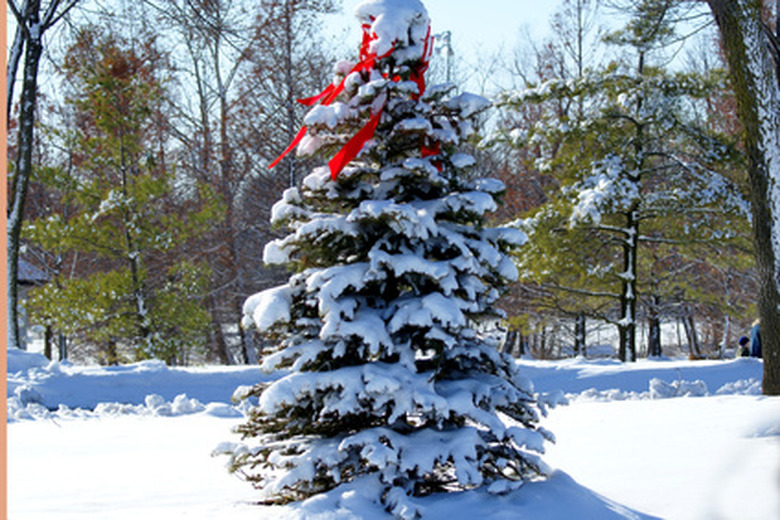Why Do Evergreens Keep Their Leaves?
The snow-mantled evergreen is a classic icon of the winter season. Every autumn, as temperatures plummet, the leaves of deciduous trees change to brilliant colors before falling to the ground, leaving evergreens the sole source of tree color upon an otherwise bleak landscape. Special adaptations allow evergreens to retain their leaves even during the most extreme winter conditions.
Deciduous Leaf Loss
Understanding why evergreens don't shed their leaves requires understanding why deciduous trees do. Leaf loss is an adaptation that helps deciduous trees survive below-freezing temperatures, though leaf loss is less about protecting trees from the winter cold than it is about conserving water. When temperatures drop below freezing, water in the ground freezes as well and cannot be taken up by the root systems of trees. The leaves of deciduous trees are broad, maximizing the surface area available for photosynthesis, but trees also lose water from their leaves, through pores called stomata found on the undersides of leaves. If deciduous trees kept their leaves in winter, the sun would evaporate water from the leaves that the tree couldn't recover from the ground, slowly dehydrating the tree.
- The snow-mantled evergreen is a classic icon of the winter season.
- Leaf loss is an adaptation that helps deciduous trees survive below-freezing temperatures, though leaf loss is less about protecting trees from the winter cold than it is about conserving water.
Water Retention
Evergreens have evolved a different set of protective adaptations that serve the same function: protecting the tree from dehydration during the winter. Evergreen leaves are covered with a thick waxy cuticle that prevents water loss from the leaf. Evergreen leaves also have fewer stomata than deciduous leaves, so less water evaporates from the leaves.
Photosynthesis
Leaves are designed to carry out photosynthesis, a metabolic process by which light from the sun is converted into usable chemical energy in the form of sugar. Because their leaves are so numerous, evergreens are able to capture sunlight even in shady areas where the risk of evaporation from their leaves is low. Some evergreens can withstand drought conditions for up to several years.
Cellular Organization
The cells of evergreen trees pack closer and tighter than the cells of deciduous trees. Because of this, water between the cells does not freeze and damage the plant tissues the way that it might in the less organized deciduous trees. When the weather warms, the cells expand so that they can take up water again.
- Evergreens have evolved a different set of protective adaptations that serve the same function: protecting the tree from dehydration during the winter.
- Because their leaves are so numerous, evergreens are able to capture sunlight even in shady areas where the risk of evaporation from their leaves is low.
Evergreen Leaf Loss
If ever you've stood on the thick blanket of fallen needles in an evergreen forest, then you know that evergreen trees do lose their leaves. Every year, evergreens lose a percentage of their leaves, but it is not contingent on the weather. Evergreen trees are never without all of their leaves at any single time. Replacing a full canopy of leaves takes a significant energy investment, so by retaining most of their leaves, evergreens are able to devote their resources to other areas of growth. Evergreen adaptations, therefore, are more efficient than leaf loss to protect trees from damage during the winter.
